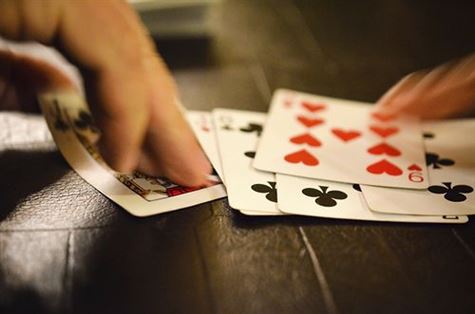Pot odds and expected value are two fundamental concepts in poker that can help players make more informed decisions and maximize their profits. Understanding these concepts requires a basic understanding of probability and mathematics. Pot odds refer to the ratio of the current size of the pot to the cost of a contemplated call. It helps players determine whether a particular bet or call is profitable in the long run. Expected value, on the other hand, is a mathematical calculation that estimates the average amount of money a player can expect to win or lose on a particular play. By considering both pot odds and expected value, players can make more strategic decisions and increase their chances of winning in the long term.
Understanding Pot Odds: A Key Strategy for Poker Players
To understand pot odds, it is important to first understand expected value. Expected value is a mathematical concept that represents the average outcome of a situation over the long run. In poker, expected value is used to determine whether a particular play is likely to be profitable or not. By calculating the expected value of a play, players can make decisions that maximize their profits.
Calculating pot odds involves comparing the current size of the pot to the cost of a contemplated call. For example, if the pot is $100 and it costs $20 to call, the pot odds are 5 to 1. This means that for every $1 you invest, you stand to win $5. If the odds of winning the hand are greater than 5 to 1, it would be a profitable play to call.
To calculate the odds of winning a hand, players must consider the number of outs they have. Outs are the cards that can improve a player’s hand. For example, if a player has a flush draw, there are 9 cards left in the deck that can complete the flush. Therefore, the player has 9 outs. By knowing the number of outs, players can calculate their chances of winning the hand.
Once the odds of winning the hand are known, players can calculate the expected value of a play. To do this, players multiply the probability of winning by the amount they stand to win and subtract the probability of losing multiplied by the amount they stand to lose. If the expected value is positive, it is a profitable play. If it is negative, it is not.
Understanding pot odds and expected value can help players make more informed decisions at the poker table. By calculating the pot odds and comparing them to the odds of winning the hand, players can determine whether a particular play is likely to be profitable or not. This can help players maximize their profits and minimize their losses.
It is important to note that pot odds and expected value are not the only factors to consider when making decisions in poker. Players must also consider their position at the table, the playing styles of their opponents, and other situational factors. However, by understanding pot odds and expected value, players can have a solid foundation for making decisions that are based on math rather than intuition.
Calculating Expected Value in Poker: How to Make Informed Decisions
Expected value is a mathematical concept that represents the average outcome of a particular decision over the long run. In poker, it is used to determine whether a play is profitable or not. By comparing the potential gains and losses of a decision, you can assess its expected value and make a more informed choice.
To calculate the expected value, you need to consider two factors: the probability of a particular outcome and the value associated with that outcome. Let’s say you are considering whether to call a bet on the river. You need to assess the probability of winning the hand and the potential value of the pot if you do win.
For example, if there is $100 in the pot and you have a 25% chance of winning, the potential value of winning the hand is $25. However, if you have to call a $50 bet to see the river, the potential loss is $50. To calculate the expected value, you multiply the probability of winning (0.25) by the potential value of winning ($25) and subtract the probability of losing (0.75) multiplied by the potential loss ($50). In this case, the expected value is $6.25 ($25 * 0.25 – $50 * 0.75).
If the expected value is positive, it means that the play is profitable in the long run. In this example, a positive expected value of $6.25 suggests that calling the bet on the river is a profitable decision. However, if the expected value is negative, it means that the play is not profitable and should be avoided.
Calculating expected value can help you make more informed decisions at the poker table. By comparing the potential gains and losses of a play, you can assess its profitability and adjust your strategy accordingly. It allows you to think beyond the immediate outcome of a hand and consider the long-term implications of your decisions.
However, it’s important to note that expected value is not a guarantee of success. It is a statistical concept that represents the average outcome over the long run. In the short term, you may experience variance and deviation from the expected value. This is why it’s crucial to have a solid understanding of probability and expected value to make the best decisions possible.
To calculate expected value accurately, you need to have a good grasp of the probabilities involved in poker. This includes understanding the odds of hitting certain hands, the likelihood of your opponents having certain cards, and the potential value of the pot. By combining this knowledge with the concept of expected value, you can make more informed decisions and increase your chances of success.
Pot Odds vs. Expected Value: Balancing Risk and Reward in Poker
Pot odds refer to the ratio of the current size of the pot to the cost of a contemplated call. It is a way of determining whether a particular bet is worth making based on the potential return. To calculate pot odds, you need to compare the size of the bet you are facing to the size of the pot. For example, if the pot is $100 and your opponent bets $20, the pot odds would be 5:1 ($100/$20). This means that for every $1 you invest, you stand to win $5.
Pot odds are important because they help you determine whether a bet is profitable in the long run. If the pot odds are greater than the odds of completing your hand, it is generally a good idea to make the call. However, if the pot odds are lower than the odds of completing your hand, it is usually best to fold. By making decisions based on pot odds, you can avoid making costly mistakes and increase your overall profitability.
Expected value, on the other hand, is a way of calculating the average amount of money you can expect to win or lose on a particular bet over the long run. It takes into account both the probability of winning and the potential payout. To calculate expected value, you multiply the probability of winning by the amount you stand to win and subtract the probability of losing multiplied by the amount you stand to lose.
For example, let’s say you have a 50% chance of winning a $100 pot and a 50% chance of losing a $50 bet. The expected value would be calculated as follows: (0.5 * $100) – (0.5 * $50) = $50 – $25 = $25. This means that, on average, you can expect to win $25 every time you make this bet.
Expected value is crucial because it helps you make decisions that are profitable in the long run. If the expected value of a bet is positive, it means that, on average, you can expect to make money by making that bet. Conversely, if the expected value is negative, it means that, on average, you can expect to lose money. By making decisions based on expected value, you can increase your overall profitability and minimize your losses.
Using Pot Odds to Determine the Profitability of a Poker Hand
To calculate pot odds, you need to know the size of the pot and the cost of the call. Let’s say the pot is $100, and your opponent bets $20. The pot odds would be 100:20, or 5:1. This means that for every $1 you invest, you have the potential to win $5.
Now, let’s consider the odds of completing your hand. If you have a flush draw with nine outs (cards that will complete your hand), the odds of hitting your flush on the next card are approximately 4:1. In this scenario, the pot odds (5:1) are higher than the odds of completing your hand (4:1), indicating that it is profitable to make the call.
However, it is important to note that pot odds alone do not guarantee profitability. You also need to consider the concept of expected value (EV). Expected value takes into account both the probability of winning and the potential payoff.
To calculate expected value, you multiply the probability of winning by the potential payoff and subtract the probability of losing multiplied by the cost of the call. Let’s say the probability of winning the hand is 30%, and the potential payoff is $200. The probability of losing is 70%, and the cost of the call is $20. The expected value would be (0.3 * $200) – (0.7 * $20), which equals $60 – $14, or $46.
If the expected value is positive, it means that, on average, you can expect to make a profit over the long run by making the call. In this case, the positive expected value of $46 indicates that it is a profitable decision to continue playing.
By using pot odds and expected value, you can make more informed decisions at the poker table. It allows you to objectively assess the profitability of a hand and avoid making costly mistakes. However, it is important to remember that poker is a game of variance, and short-term results may not always align with expected value calculations.
Maximizing Your Profits with Math: Leveraging Pot Odds in Poker
Pot odds refer to the ratio of the current size of the pot to the cost of a contemplated call. It is a fundamental concept in poker that allows players to make informed decisions about whether to continue in a hand or fold. By comparing the potential reward of winning the pot to the cost of calling a bet, players can determine whether the odds are in their favor.
For example, let’s say there is $100 in the pot and your opponent bets $20. In order to call, you would need to put $20 into the pot. The pot odds in this scenario would be 5:1 ($100/$20). This means that for every $1 you put into the pot, you have the potential to win $5. If you believe that your chances of winning the hand are greater than 1 in 5, then calling would be a profitable decision in the long run.
Expected value, on the other hand, takes into account both the pot odds and the probability of winning the hand. It is a way of quantifying the potential profitability of a particular decision. By calculating the expected value of a given action, players can determine whether it is a profitable move in the long run.
To calculate the expected value, you multiply the probability of winning the hand by the potential reward and subtract the probability of losing multiplied by the cost of the action. If the expected value is positive, it means that the action is likely to be profitable over time.
Let’s go back to our previous example. If you believe that you have a 25% chance of winning the hand, the expected value of calling would be calculated as follows: (0.25 * $100) – (0.75 * $20) = $25 – $15 = $10. Since the expected value is positive, calling would be a profitable decision in the long run.
By understanding and utilizing pot odds and expected value, players can make more informed decisions at the poker table. Instead of relying solely on intuition or luck, they can use mathematical principles to maximize their profits.
It is important to note that pot odds and expected value are not foolproof strategies. They are tools that can help guide decision-making, but they do not guarantee success. Poker is a game of skill and chance, and there will always be an element of uncertainty.
However, by incorporating these mathematical concepts into your gameplay, you can increase your chances of making profitable decisions. Over time, consistently making +EV (positive expected value) moves will lead to greater profitability and success at the poker table.
In conclusion, pot odds and expected value are essential concepts for any serious poker player. By understanding the relationship between the size of the pot, the cost of a call, and the probability of winning, players can make more informed decisions and maximize their profits. While luck will always play a role in poker, it is the players who leverage math to their advantage that often come out on top. So, the next time you sit down at the poker table, remember to consider the pot odds and expected value before making your move.




